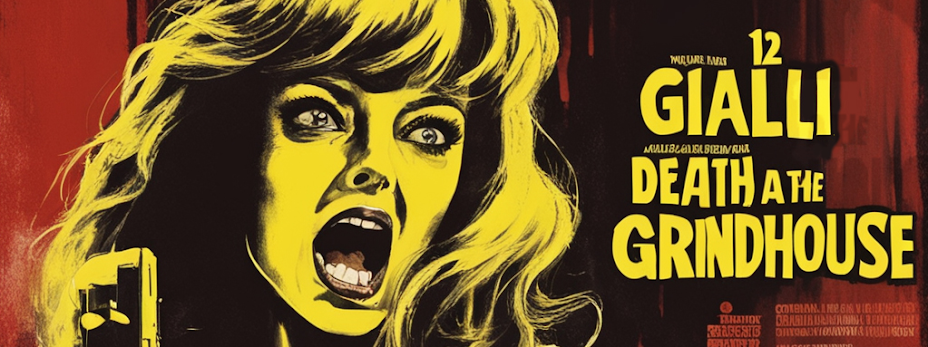1. A Slit in my Dress - The illustrated biography of Ingrid Steeger
I am not necessarily a fan of Ingrid Steeger but her appearance and willingness to go all in was one of the remarkable popular culture phenomenoms of Germany in the 70ies. Easily the biggest star to come out of the Schulmädchen-Report series, she also starred in BDSM loops, Edgar Wallace Krimis, had affairs with some of the biggest players in the media industry and became a national icon as "Gaby" in the long running "Klimbim" series (which was the most anarchic thing ever to be shown on german TV).
Easily the biggest star to come out of the Schulmädchen-Report series, she also starred in BDSM loops, Edgar Wallace Krimis, had affairs with some of the biggest players in the media industry and became a national icon as "Gaby" in the long running "Klimbim" series (which was the most anarchic thing ever to be shown on german TV).
Her lead role in "Me, a Groupie", EC Dietrich's sleazefest about the drug- and girl-abusing music scene is legendary.
Although not well-off in the later years she stubbornly refused to be part of TVs star-at-the-end-of-their-lifecycle-shredding system consisting of humiliating dance-shows, jungle-challanges and voyeuristic container life. They don't make 'em like that anymore.
A yes, in case you do not know what I'm talking about...
There is this tremendously fascinating book about Brigitte Lahaye in France and that should be the benchmark.
2. Delirio Polsello - The definitive book on Renato Polselli.
He is my favourite italian director. Audacious, mind-opening, daring and basically failing for pursuing his vision: The liberation of the audience's perception. When Jess Franco and all the others were only titillating our senses, promising more than delivered, he went all the way. His lesser known movies are dangerous to watch.Maybe David Flint and Kim Newman will read this and feel offended. I felt offended by their total lack of dedication. I know, there is a FULL Rita Calderoni interview on the movie on youtube, that was just ignored (in the booklet, in the documentary of course by the commentators). I mean, it is in italian, so it cannot be be important, right?. I consider that to be culturally condescending. Sorry. There are technical abilities to translate youtube videos, or just ask some random Italian here in one of the facebook groups to translate.
- And of course HD-scans of his basically unavailable works. The prints are out there, I've seen one in a cinema .... lately.
3. All the Colors of the Dark - A revised and extended edtion by Tim Lucas
I missed out the first time, I had a mortage going on the house etc. This time I am willing and free to invest in an updated version of the book, but not willing to pay the ridiculous prices for the old one on the used-book auctions. Furthermore, all the information has already popped up in the internet and Tim basically gave away the PDF-file for a while. Tim, if you're reading this, count me in at EVERY 3-digit price.
4. The Peter Thomas Tribute Orchestra live Krimi Screening Tour 2025
Everybody's doing it. I just saw Hans Zimmer doing it. What I would give to have an authentic jazz orchestra performing "Witcher" live, with the best sequences projected in the back.5. Raumpatrouille Orion relaunch
 |
| Friedrich Dürrenmatt's wife Charlotte Kerr being far too dominant as General van Dyke (sic!). |
6. Krimi! The Magazine
A dedicated magazine to middle-european crime movie culture, throughly researched with new perspectives in each issues.
Eye-opening new information and complete background stories about the movies, the actors, directors and the business.
Just like my blog here...
maybe I will grant me a wish...
Anyone with me??
7. Legislation that prohibits the exploitation of an artist's work by whoever inherits the rights if deemed so by the artist in his last will
Two incidents made me furious. The exploitation of Steve Ditko by his heirs and the publication of novels by Franz Kafka.
 |
| Ditko's last big drawing before leaving Marvel. He really was free. |
People suck.
In a big way.
Most of the time.
8. Recognition of Karin Dor as the ultimate Scream Queen of the 1960s
She assisted aliens in taking over the world
She loved Dracula
She resurrected Frankenstein's Monster and the Mummy
She fought the Werewolf
She tortured and loved James Bond
She was the OG razor-blade giallo slasher/ripper killer
She fled from Dr. Mabuse
She was Odin's Daughter
She was raped by the invisible man
She knew the last of the Mohicans
She survived the Strangler of Blackmoor Castle, the Forger, the Green Archer, the Sinister Monk and Dr. Fu Manchu
She did not survive Che Guevara
She was strapped under the swinging blade pendulum
She was Winnetou's great love
She worked with Alfred Hichcock, Sean Connery, Christopher Lee, Lex Barker, Paul Naschy
Can someone please write a definitve biography on her aknowledging her work in the genre (that she never distanced herself from)...
 |
| source: Forum user KXL556 |
9. Nicholas Winding Refn's Remake of "Grapes of Death"
10. Rita Calderoni at the Buio Omega Birthday Party
If you know what I'm talking about, you know. If you don't ... well than it is exactly how it should be.












